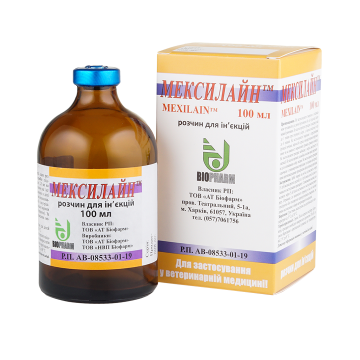MEXILINE
solution for injections
Description
Transparent yellow solution.
Composition
1 ml of the drug contains:
active ingredient: meloxicam - 20 mg.
Excipients: Macrogol 300, sodium hydroxide, water for injections.
solution for injections
Description
Transparent yellow solution.
Composition
1 ml of the drug contains:
active ingredient: meloxicam - 20 mg.
Excipients: Macrogol 300, sodium hydroxide, water for injections.
Pharmacological properties
ATC-vet index: QМ01A - nonsteroids, anti-inflammatory and anti-rheumatic products. QM01AC56 - Meloxicam.
Meloxicam, a non-steroidal anti-inflammatory drug of the oxycam class, is a selective COX-2 inhibitor. It has anti-inflammatory, analgesic and antipyretic effects. The mechanism of action consists in a decrease in the biosynthesis of prostaglandins due to inhibition of the enzymatic activity of COX-2, involved in the synthesis of prostaglandins in the inflammatory focus; slightly affects COX-1, reducing the risk of side effects.
Meloxicam bioavailability is almost 100%. After intramuscular administration of the drug at a dose of 5 mg meloxicam/kg body weight, the maximum concentration is 1.62 mcg/ml and is reached within approximately 60 minutes. Meloxicam is well bound to plasma proteins, especially albumin (99%). It penetrates the synovial fluid, the synovial fluid concentration is approximately 50% of the plasma concentration.
Meloxicam is almost completely metabolized in the liver to form 4 inactive derivatives. The main metabolite, 5'-carboxymeloxicam (60% of the dose volume), is formed by oxidation of the intermediate metabolite of 5'-hydroxymethylmeloxicam, also excreted but in smaller amounts (9% of the dose volume).
Approximately 50% of the administered dose of meloxicam is excreted in urine, the rest - in feces.
Average half-life makes about 20 hours. Plasma clearance averages 8 ml/min. Meloxicam demonstrates linear pharmacokinetics in doses of 7.5-15 mg by intramuscular administration. Hepatic or renal insufficiency of moderate severity does not significantly affect meloxicam pharmacokinetics.
Administration
Cattle: treatment of animals with acute inflammation of the respiratory organs (in case of appropriate antibiotic therapy); as an adjunct to the treatment of calves (older than 1 week), patients with diarrhea in combination with rehydration therapy; purulent-catarrhal mastitis in combination with appropriate antibacterial therapy; to relieve postoperative pain after removal of horns in calves.
Horses: as an anti-inflammatory and analgesic agent in chronic and acute diseases of the musculoskeletal system and colic.
Swine: treatment of animals with musculoskeletal system diseases (to reduce lameness and inflammation symptoms), as well as adjunctive therapy in the treatment of postpartum septicemia and mastitis-metritis-agalactia syndrome in case of appropriate antibiotic therapy.
Dosage
Administer once a day in the following doses:
cattle - subcutaneously or intravenously at a dose of 2.5 ml per 100 kg of animal weight (0.5 mg of meloxicam per 1 kg of animal weight);
horses - intravenously at a dose of 3.0 ml per 100 kg of animal weight (0.6 mg of meloxicam per 1 kg of animal weight);
swine - intramuscularly at a dose of 2.0 ml per 100 kg of animal weight (0.4 mg of meloxicam per 1 kg of animal weight). If necessary, re-introduction of meloxicam after 24 hours is possible.
Contraindications
Do not administer to animals with hypersensitivity to the active substance or excipients.
Do not administer the drug to foals under 1 week old for diarrhea, as well as to foals under 6 weeks old.
Do not administer to animals with impaired liver, kidney or heart function, hemorrhagic disorders or gastrointestinal ulcers.
Do not administer the drug to mares during pregnancy and lactation.
Do not administer to mares whose milk is intended for human consumption.
Do not use the drug in combination with glucocorticosteroids and other nonsteroidal anti-inflammatory drugs or anticoagulants.
Precautions
Side effect
After subcutaneous administration to cattle, as well as after intramuscular administration to horses, minor and transient swelling at the injection site may be present.
Very rare anaphylactic reactions, requiring symptomatic treatment.
Special precautions for administration
If treatment with other nonsteroidal anti-inflammatory drugs is not effective, the drug is prescribed no earlier than 24 hours after withdrawal of the previous drug, under the veterinarian's supervision.
Do not administer to animals with severe dehydration, hypovolaemia or hypotension, requiring parenteral rehydration, with potential risk of nephrotoxicity.
Administration in pregnancy (lactation)
The drug can be used in cattle and swine during pregnancy and lactation.
Excretion (withdrawal) period
Animal slaughter for meat is allowed in 15 days (cattle) and 5 days (swine, horses) following the last drug administration. Milk consumption is allowed in 5 days following the last administration of the drug. Meat and milk, obtained before the mentioned term, shall be utilized or fed to non-productive animals depending on the veterinary physician’s recommendation.
Packaging
Glass vials of 100 ml sealed with rubber stoppers and aluminum caps.
Storage
Store in a dry dark place out of the reach of children at 5-30 °С.
Shelf life - 3 years.
Use the drug within 28 days following the initial withdrawal from the vial provided it is stored in a dry, dark place at 2-8 С.
For veterinary use only!
